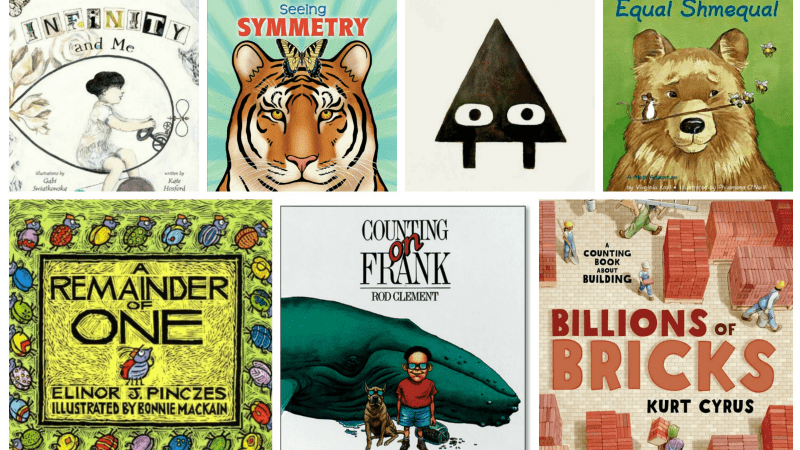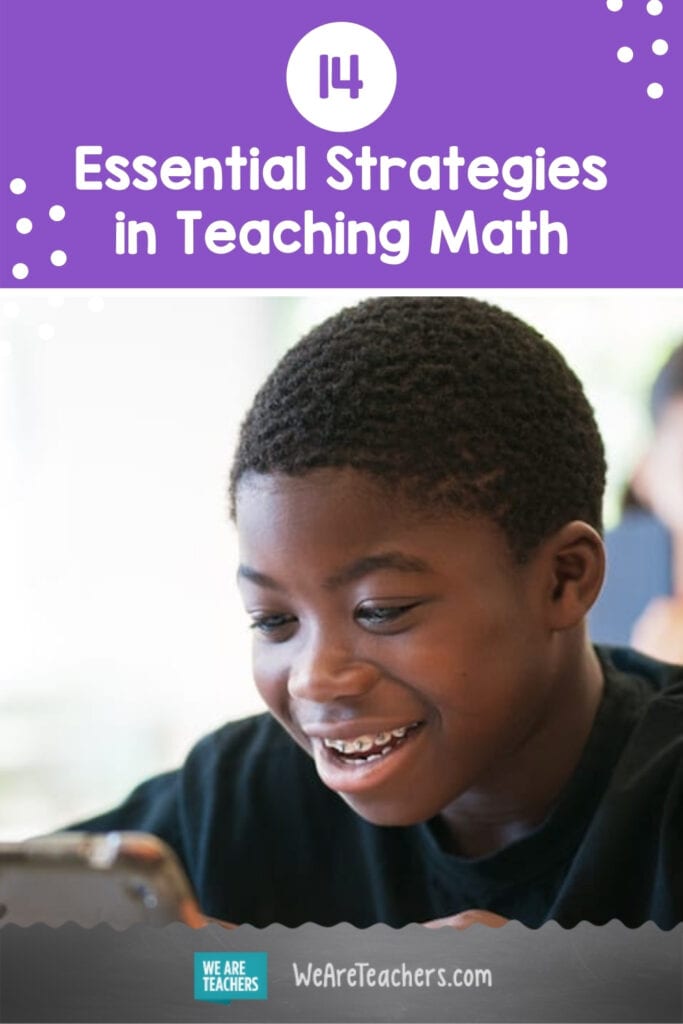What Is The Best Way To Learn Mathematics And Keep The Interest Level High For College Students?
We all desire our kids to succeed in math. In most districts, standardized tests mensurate students' understanding, notwithstanding nobody wants to teach to the examination. Over-reliance on exam prep materials and "drill and kill" worksheets steals instructional time while besides harming learning and motivation. But sound teaching and expert exam scores aren't mutually exclusive. Being intentional and using creative approaches to your instruction can go students excited almost math. These 14 essential strategies in teaching mathematics can brand this your class'south all-time math twelvemonth ever.
1. Raise the bar for all

Property high expectations for all students encourages growth. As early as second grade, girls take internalized the idea that math is not for them. It tin be a challenge to overcome the socially acceptable idea, I'm not good at math, says Sarah Bax, a math teacher at Hardy Centre School in Washington, D.C.
Rather than being born with or without math talent, kids demand to hear from teachers that anyone who works difficult tin succeed. "It's nigh helping kids have a growth mindset," says Bax. "Practice and persistence make y'all proficient at math." Build math equity and tell students about the power and importance of math with enthusiasm and loftier expectations.
(Psst…yous can snag our growth mindset posters for your math classroom here.)
two. Don't expect—deed now!
Look ahead to the specific concepts students need to chief for annual end-of-year tests and pace teaching appropriately. Call back about foundational skills they will need for time to come learning.
"You don't desire to be caught off guard come up March thinking that students need to know 10 for the tests the next calendar month," says Skip Fennell, projection director of Uncomplicated Mathematics Specialists and Instructor Leaders Project and professor emeritus at McDaniel College in Westminster, Maryland. Know the specific standards and back-map your teaching from the fall so students are ready.
3. Create a testing pathway
You may not fifty-fifty see the results of standardized tests until next schoolhouse twelvemonth, but y'all take to teach to information technology now. Use formative assessments to ensure that students understand the concepts. What yous acquire can guide your instruction and determine the next steps, says Fennell.
Testing is not something separate from your educational activity. It should exist integrated into your planning. Instead of a quick exit question or bill of fare, give a five-minute quiz to confirm students have mastered the math skill covered in the twenty-four hour period's lesson. A capable digital resource, designed to monitor your students in real-time, can also be an invaluable tool, providing actionable data to inform your teaching along the way.
4. Observe, modify, and reevaluate
Sometimes we get stuck in a mindset of "a lesson a day" in club to get through the content. However, we should proceed our pacing flexible, or kids can fall backside. Walk through your classroom as students work on problems and observe the dynamics. Talk with students individually and include "hinge questions" in your lesson plans to gauge understanding earlier continuing, suggests Fennell. In response, make decisions to become faster or slower or put students in groups.
v. Connect math to other learning areas

The more nosotros show students how math is connected to the world around us, the more than invested they go. Read books with math connections. Talk nearly the ways math integrates with visual arts and music. These conversations volition assistance reinforce how mathematical thinking can help kids in all subject areas.
6. Personalize and offer choice
When students are given the opportunity to choose how they acquire and demonstrate their understanding of a concept, their purchase-in and motivation increase. It gives them the chance to empathize how they learn best, provides agency over their own learning, and allows for the infinite to practice different approaches to solving math problems. Give students a variety of options, such as timed exercises, projects, or different materials, to show that they've mastered foundational skills. Equally students prove what they've learned, teachers can runway understanding, effigy out where students need additional scaffolding or other aid, and tailor lessons accordingly.
7. Encourage math talk
Communicating about math helps students procedure new learning and build on their thinking. Engage students during conversations and have them describe why they solved a problem in a certain fashion. "My goal is to get data about what students are thinking and use that to guide my education, as opposed to simply telling them data and asking them to parrot things back," says Delise Andrews, who taught math (Yard–8) and is at present a 3–v grade math coordinator in the Lincoln Public Schools in Lincoln, Nebraska.
Instead of seeking a specific answer, Andrews wants to take deeper discussions to figure out what a student knows and understands. "True learning happens a lot around talking and doing math—non simply drilling," she says.
8. Play math games
Student engagement and participation can be a claiming, especially if you're relying heavily on worksheets. Games are an excellent way to brand the learning more fun while simultaneously promoting strategic mathematical thinking, computational fluency, and understanding of operations. Games also foster a dwelling-school connection when they're sent habitation for actress do.
9. Emphasize easily-on learning
In math, in that location's then much that'south abstract. Hands-on learning helps make the conceptual physical. Consider incorporating math manipulatives whenever possible. For case, yous tin employ LEGO bricks to teach a variety of math skills , including finding area and perimeter and understanding multiplication.
10. Seek to develop understanding
Meaningful math didactics goes beyond memorizing formulas and procedures. Memorization does not foster agreement. Gear up high goals, create space for exploration, and work with the students to develop a strong foundation. "Treat the kids like mathematicians," says Andrews. Present a broad topic, review various strategies for solving a problem, and then elicit a formula or thought from the kids rather than starting with the formula. This creates a stronger conceptual understanding and mental connections with the material for the student.
11. Cull meaningful tasks.

Kids get excited about math when they have to solve real-life issues. For example, when teaching sixth graders how to determine area, present tasks related to a house redesign, suggests Fennell. Provide them with the dimensions of the walls and the size of the windows and have them make up one's mind how much space is left for the wallpaper. Or ask them to consider how many tiles they would demand to fill a deck. You lot can absolutely introduce problem-based learning, even in a virtual world.
12. Let for productive struggle
When giving students an authentic problem, ask a large question and permit them struggle to figure out several ways to solve it, suggests Andrews. "Your job, as a instructor, is to brand it engaging past asking the correct questions at the right time. So you lot don't take abroad their thinking, but you help them motion forward to a solution," she says.
Provide as little information equally possible merely enough and so students can be productive. Constructive math education supports students as they grapple with mathematical ideas and relationships. Allow them to detect what works and experience setbacks along the way as they adopt a growth mindset about mathematics.
thirteen. Build excitement and reward progress
Students—especially those who haven't experienced success—tin have negative attitudes most math. Consider having students earn points and receive certificates, stickers, badges, or trophies equally they progress. Weekly announcements and assemblies that celebrate the top players and teams tin can be really inspiring for students. "Having that recognition and moment is powerful," says Bax. "Through repeated do, they get better, and they are motivated."
14. Encourage teacher teamwork and reflection
You can't teach in a vacuum. Collaborate with other teachers to meliorate your math instruction skills. Start by discussing the goal for the math lesson, what information technology will look like, and program equally a team to be most effective. "Together, think through the tasks and possible student responses you might encounter," says Andrews. Reflect on what did and didn't work to amend your practice.
What do y'all feel are the near of import strategies in teaching mathematics? Share in the comments below.
Desire more articles similar this? Make sure to subscribe to our newsletters.
Learn why it's important to honor all math strategies. Plus, check out the all-time math websites for teachers .

What Is The Best Way To Learn Mathematics And Keep The Interest Level High For College Students?,
Source: https://www.weareteachers.com/strategies-in-teaching-mathematics/
Posted by: whitesideitere1944.blogspot.com


0 Response to "What Is The Best Way To Learn Mathematics And Keep The Interest Level High For College Students?"
Post a Comment